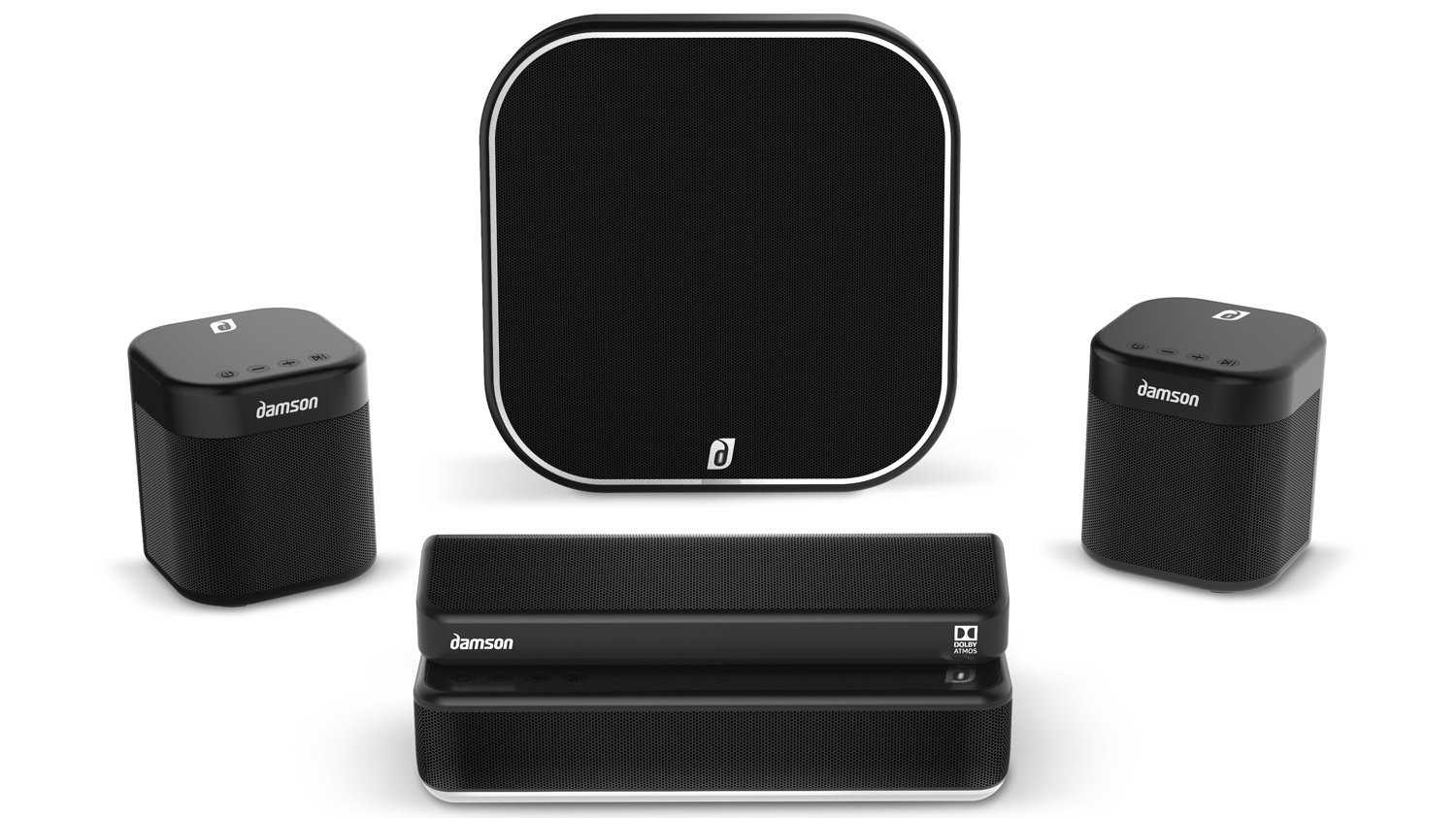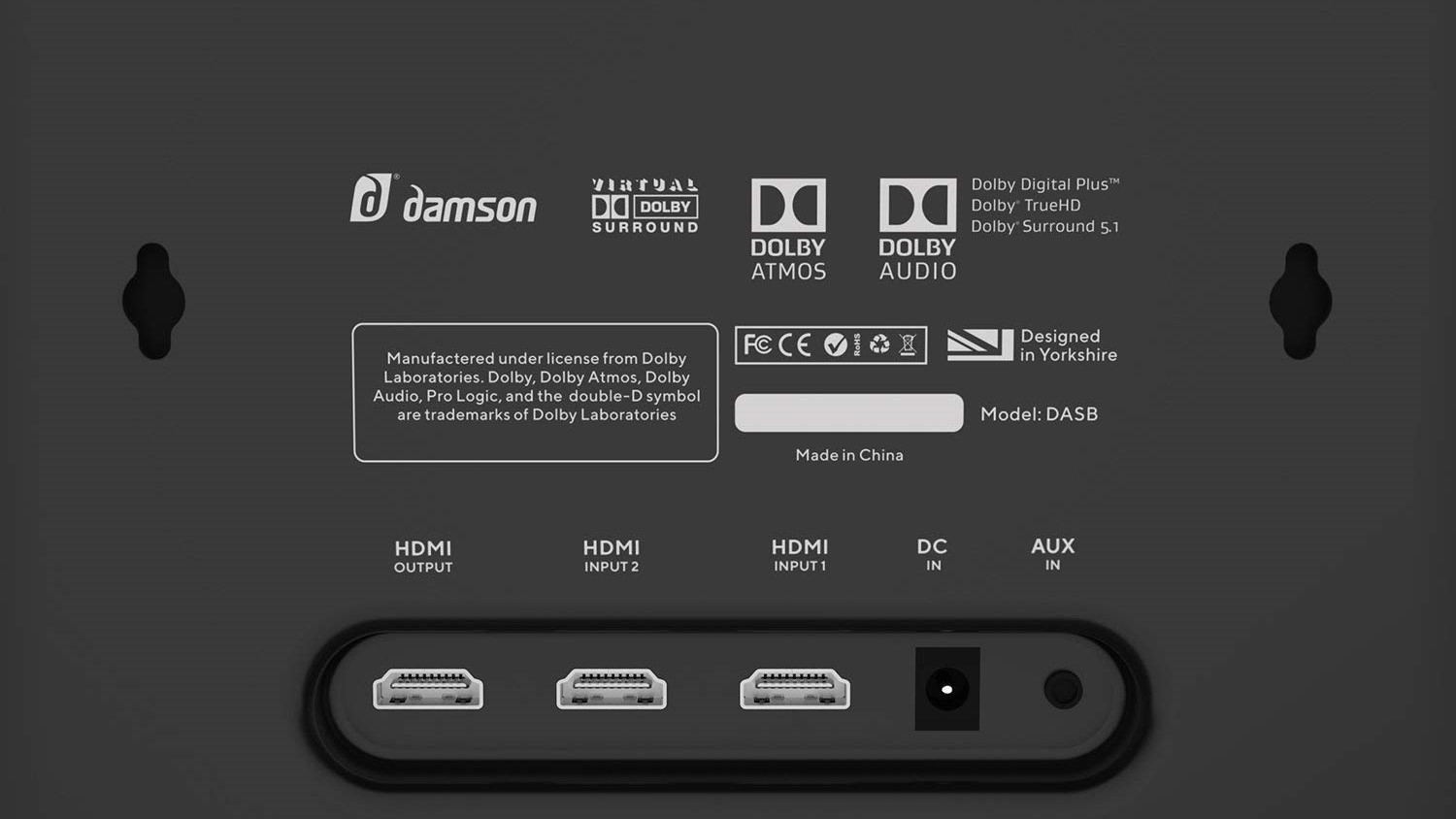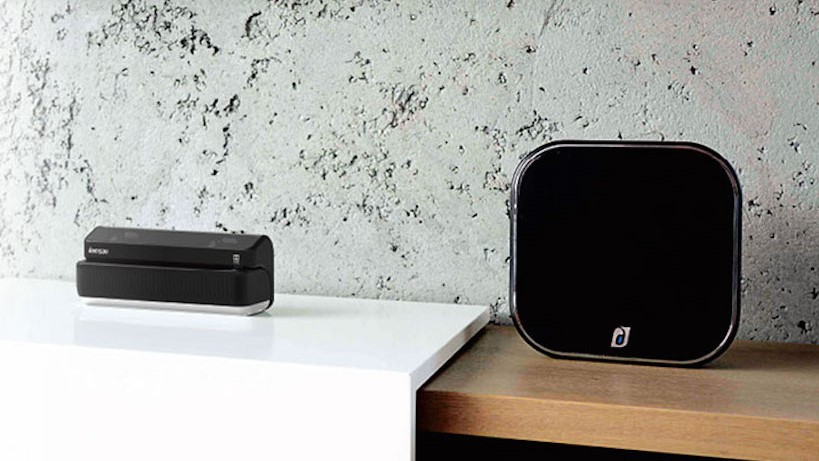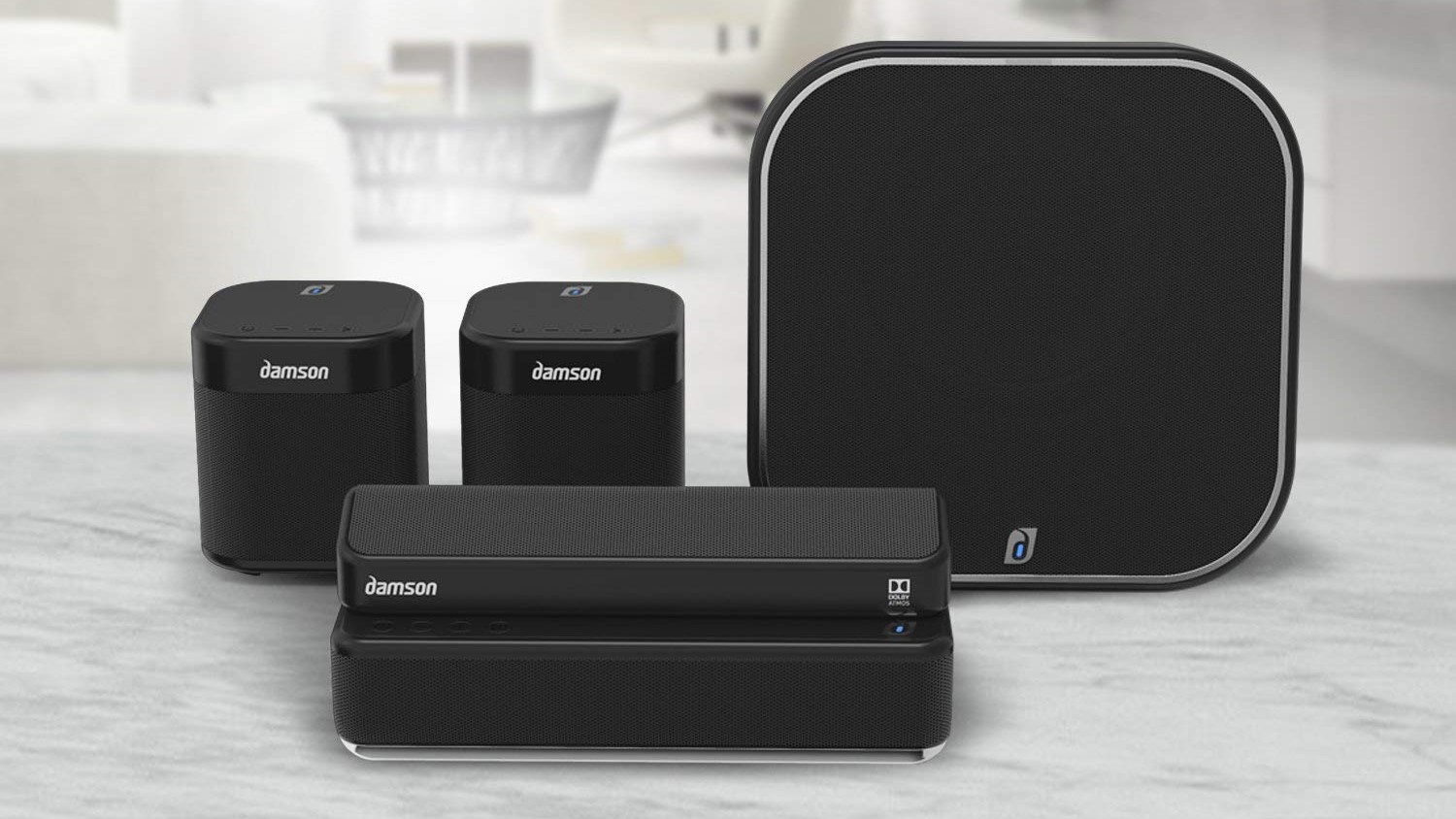TechRadar Verdict
The S-Series is a clever and convenient attempt to solve the problem of how to get a ‘true’ Atmos sound from a compact and cable-free speaker package. Unfortunately, though, there are too many audio quality compromises for comfort - especially for a system that costs £799 / $799.
Pros
- +
Remarkably compact design
- +
Includes surround/height speakers
- +
All speakers are wireless
- +
Decent build quality
Cons
- -
Bass is very limited
- -
Vocals can sound distorted
- -
Exaggerated trebles
- -
Too expensive
Why you can trust TechRadar
Damson’s S-Series speaker system stands out from the fast-growing hordes of convenient Dolby Atmos sound solutions in a couple of potentially exciting ways.
First, it’s incredibly compact for a system that provides a genuine 5.1.2 speaker configuration. Second, every part of its speaker system, from the separate rears through to its subwoofer, centre/left/right soundbar and two upfiring drivers, communicate with each other completely wirelessly. The only wires in sight here are power cables.
Put these two key features together and the Damson S-Series could be just the living room friendly but also uncompromising Atmos solution home cinema fans have been waiting for. (Spoiler: It's not.)
Design

Dimensions: Soundbar: 240(w) x 65(h) x 75(d)mm | Speaker configuration: 5.1.2 | Claimed audio power: 130W | Connections: Two HDMIs in, one HDMI out (4K HDR/Dolby Vision loopthrough supported), Bluetooth
Looking at the S-Series’ diminutive box, it’s hard to believe that tucked away inside is a set of five individual speaker components. But tucked inside they are - and it’s apparent as you start unpacking them that while they be small, some components, at least, are very well built.
This is especially true of the two rears, which are weighty enough to serve as bookends. Except that you can’t actually use them as that, since they have drivers mounted down their sides as well as across their fronts, to help them deliver the wider sound expected of the Dolby Atmos ‘object-based’ sound system. This places sounds within a created 3D audio space rather than simply reproducing sounds directly at a particular speaker ‘channel’.
The remarkably small front soundbar slots into a neat ‘Dolby Atmos’ adaptor that carries two up- and slightly forward-firing speakers designed to deliver Atmos’s height channel effects by reflecting sound off your ceiling. Little magnets hold the centre speaker firmly in the jaws of the Atmos adaptor, and the adaptor also draws its power from the slotted-in centre. It doesn’t need a separate power supply.
There is one problem with the Atmos adapter, though. The thing is, it stands nearly 12cm tall - high enough to jut up into the picture of most TVs if you simply place it on the table in front of your TV’s stand. And you can’t hide it in a shelf below the TV, as this may disrupt the upfiring speakers on the Dolby Atmos adapter.
Sign up for breaking news, reviews, opinion, top tech deals, and more.

While the Atmos adaptor is too tall, the 240mm-wide centre speaker is actually quite alarmingly small for a speaker that’s going to carry so much sound quality weight on its shoulders.
The same is true, actually, of the subwoofer component. It does manage to cram a pretty big, front-firing driver into its patented ‘UltraThin’ frame, but its lack of any depth and slightly flimsy build quality raises concerns about just how low it might be able to go.
Neither the subwoofer nor any other part of the system carries an LED display. Instead, the only way to keep track of what input you’ve got selected is a colour coded lighting system on the sub and centre speakers. The lack of a display is disappointing for an $800/£800 system - as is the minimal amount of control options provided by the rather lightweight remote control.
The remote also loses points for weirdly cramming all of its buttons into a weirdly small area of its surface, and for not making those buttons very prominent.
All parts of the system are reasonably attractive and nicely finished. So long, anyway, as ‘mostly black with metallic silver trim’ is your thing.
Features
The S-Series’ headline grabbers are its remarkably compact speakers, wireless five-speaker set up, and support for Dolby Atmos. There are, though, a few more bits and bobs worthy of mention.
For starters, while the S-Series doesn’t carry decoding of the DTS:X object-based sound system (as supported by a growing number of 4K Blu-rays, including the recently released Jurassic Park boxset), it does at least convert DTS:X into Dolby Digital Plus.
While this doesn’t provide DTS:X’s true object-based effect, it is at least a handy step up from the much more limited conversion situation witnessed with some previous Dolby Atmos soundbars/compact systems.
The system’s connectivity is all found on the subwoofer. This could prove annoying for some, given that many people like to hide subwoofers (which produce non-directional sound) out of sight rather than placing them near their TV and other AV kit.

The connections comprise two HDMI inputs, an HDMI output with Audio Return Channel (ARC) support, an AUX input, and Bluetooth. The HDMI loopthrough impressively supports Dolby Vision passthrough as well as HDR10. Though I should say that while the loopthrough worked fine with Oppo 203 and Sony X700 4K Blu-ray players, it didn’t work with my Panasonic UB900 for some reason.
All the speakers in the system talk to each other via the JetStreamNet wireless platform, and the ’S-Cube’ rears even carry built in rechargeable Lithium Ion batteries so you don’t need to tether them to plug sockets when you’re using them. Provided you’ve remembered to charge them up first.
The rears are reckoned to run for around eight hours at 70% volume on a full charge - and this figure didn’t seem overly optimistic during our tests.
It’s worth adding, too, that you can chain eight S-Cubes together if you wish, for a multi-speaker, multi-room set up.
The core S-Series system pumps out a claimed 130W of sound. Which in truth doesn’t sound much when you consider that Samsung’s HW-K950 system delivers 500W of total power output. Hopefully the speakers prove sensitive enough to maximise the potential of those 130 Watts.

Performance
The Damson S-Series’ sound quality is a mixed bag that slightly struggles to justify its hefty price tag. That said, it does succeed from time-to-time.
Starting with the good news, the system sparkles when it comes to delivering effects all around your room. There are bold transitions from front to back, back to front and side to side, and effects are placed within the Dolby Atmos 3D space with precision and clarity. This even applies to the height channel effects, with Damson’s ‘ceiling deflection’ approach working much better than I would have expected from a system that’s not exactly spilling over with power.
In an ideal world the rear speakers would have carried angled up-firing speakers too, but the deflection system deployed by the ‘Atmos adaptor’ still manages to create a passable sense of Dolby Atmos’s audio ‘bubble’.
The Atmos bubble is large enough in scale to fill a mid-sized room, too, and the fronts and rears are nicely matched in tone.
On the flip side, the biggest problem is the lack of bass. The subwoofer doesn’t just struggle to deliver really deep, powerful bass - it struggles to make itself heard at all. There’s just a vague, withdrawn sense of distant rumbling during scenes that I know from experience should have your foundations cracking.
As well as selling Dolby Atmos’s bass attribute short, the reluctance/inability of the subwoofer to make itself heard proves a big problem for the centre speaker. Most subwoofer/soundbar systems rely on the subwoofer to latch onto the bottom end of the soundbar’s bass range to stop it from sounding exposed in the mix. But with the S-Series, the soundbar is left sounding rather tinny and treble-biased by the lack of adequate help from the subwoofer.

The exceptional smallness of the soundbar component also creates a noticeable funnelling effect, where the rear speakers deliver an impressively wide soundstage behind you while the front soundbar sounds relatively narrow thanks to its inability to disperse its audio far to the left or right.
This narrowness of the soundbar’s audio splay makes the front soundstage appear more like a column of sound, too, than the sort of wall of sound you’re really looking for to develop a full Atmos sound ‘sphere’.
The soundbar section also starts to distort and ‘hum’ if pushed hard by dense content - including rich, deep voices - at high volumes.
Switching from movies to music, the S-Series struggles. The system’s lack of bass is again a problem, leaving you with the sort of slightly tinny, thin sound associated with small portable speakers than the well rounded sound you’d hear from a decent hi-fi system. This lack of bass can leave high musical trebles sounding a little shrill and exposed.

The system does have one musical strength: detail. You can really hear all the separate elements that go into a high quality musical mix. But over-egged trebles and under-egged bass means that those elements don’t gel together consistently convincingly.
Note, finally, that an X-Bass feature provided via the remote control doesn’t inject much more low frequency response at all. Nothing, it seems can kick the subwoofer into life.
Performance TL;DR: The S-Series does a better job of delivering a true object-based audio detailing than pretty much any similarly priced Atmos solution. Bass is in alarmingly short supply, though, and the main soundbar section lacks the power and scale to deliver a convincing front soundstage. The system struggles with music, too.
Other sound systems to consider...
While you might struggle to find another one-box Atmos system that delivers such a genuine Atmos experience when it comes to height and rear effects it can be done:
The Samsung HW-K950 5.1.4 system remains the undisputed champ of Dolby Atmos ‘one box’ solutions. Its power and dynamic range - especially at the bass end of things - are in a different league to the S-Series’ efforts.
If you’re looking to match the S-Series’ $799/£799 price, however, the Samsung HW-K850 system gives you a far more powerful front soundstage and bass performance, as well as a decent sense of height. There are no rear speakers, though.
If you don't mind dropping down a bit further, the Samsung HW-MS650 provides tough competition at a cheaper price level. This ‘single enclosure’ solution delivers remarkable power and bass for a single soundbar solution, and only costs around half as much as the S-Series - though, there’s no Atmos decoding or height channel effects.
Verdict
The Damson S-Series is a partial success. It manages to deliver the detail and clarity you want with a Dolby Atmos system from a remarkably small collection of speakers.
While it might be easy on your decor, though, those small speakers do lead to some pretty significant compromises when it comes to the bass and front channel sound ‘spread’ you need to do Dolby Atmos full justice. From a sound quality perspective, you’re essentially having to decide if you want full surround but with minimal bass and rather lightweight sound quality, or a much more powerful front soundstage with no real surround sound details.
- These are the best Dolby Atmos speakers on the market

John has been writing about home entertainment technology for more than two decades - an especially impressive feat considering he still claims to only be 35 years old (yeah, right). In that time he’s reviewed hundreds if not thousands of TVs, projectors and speakers, and spent frankly far too long sitting by himself in a dark room.
